Asus P8Z77-V Premium Review: Flagship Mainboard from Asus

This mainboard is based on Intel Z77 Express and offers extensive networking and wireless functionality. It comes with a pre-installed mSATA drive and supports Thunderbolt. This is a very high-end model for those users who need maximum functionality immediately.
At this time it would be fair to day that we are already well familiar with the features and functionality of Asus mainboards on Intel Z77 Express chipset. We have reviewed the only “TUF” (The Ultimate Force) series mainboard – Asus Sabertooth Z77, and one of the four ROG (Republic of Gamers) products – Asus Maximus V Formula. We also looked at one of the entry-level products from Asus – Asus P8Z77-V LX, and our entire series of Intel Z77 Express based products reviews was proudly opened by Asus P8Z77-V Deluxe. The features and functionality of the Asus P8Z77-V Deluxe was quite expectedly expanded due to a large number of additional controllers, so even simply listing all of them could take long. This list includes two SATA 6.0 controllers, two USB 3.0 controllers, two Gigabit network controllers, a special hub providing additional PC Express 2.0 lanes and “Wi-Fi GO!” module for wireless technologies. Although Asus P8Z77-V Deluxe is much more functional than an average mainstream mainboard on Intel Z77 Express, this model was the top of the line only while we were working on its review. By the time the review posted, it was no longer the top model in the product range, because by that time Asus already announced an even more advanced flagship product – Asus P8Z77-V Premium. Let’s find out what makes this mainboard stand out among other Asus products as well as competitors.
Packaging and Accessories
Asus P8Z77-V Premium mainboard comes in a pretty large box with a carry-handle. The front flip cover is attached with Velcro pads, and reveals almost the entire mainboard through a clear plastic window. The inside of the flip-cover as well as the back of the box bear brief description of the mainboard peculiarities, a mainboard photograph and a list of technical characteristics.
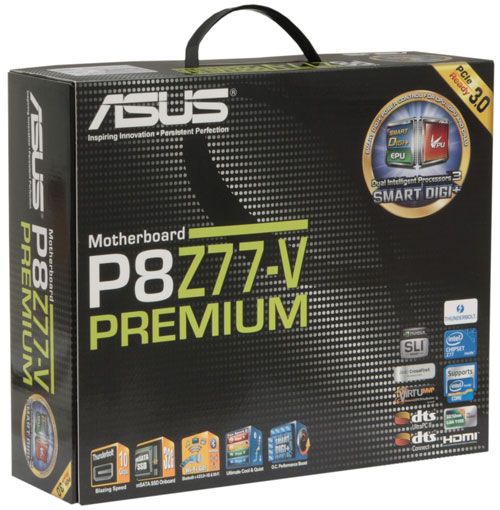
The mainboard itself is wrapped in a traditional antistatic plastic bag and is secured inside a sturdy cardboard casing. Beneath the board there is a large two-section box for numerous accessories:
- Six Serial ATA cables with metal L-shaped connector locks. Two pairs are specifically designed for SATA 6 Gbps devices (with white inserts in the connectors);
- A flexible bridge for two-way Nvidia SLI graphics configurations;
- A hard bridge for 3-way Nvidia SLI graphics configurations;
- A hard bridge for 4-way Nvidia SLI graphics configurations;
- Wi-Fi GO! module (AzureWave AW-NB111H);
- Two Wi-Fi ring antennas;
- A module with two USB 3.0 ports for the 3-inch bay of the system case;
- I/O Shield for the back panel;
- “Asus Q-Connector” kit including adapters for easy connection of the system case front panel buttons and indicators and a USB 2.0 port;
- User manual;
- An informational brochure about “Wi-Fi GO!”, Fan Xpert 2”, “Network iControl” and “USB Charger+” utilities;
- “Wi-Fi GO!” module manual;
- DVD disk with software and drivers;
- “Powered by Asus” sticker for the system case.
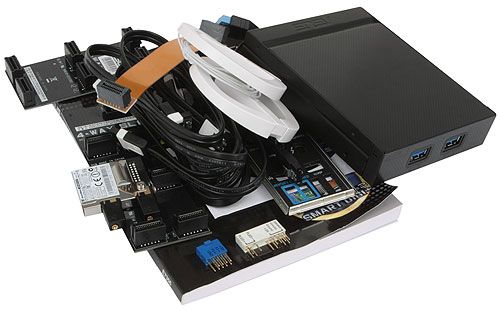
You can easily spot the differences between the accessories bundle of the Asus P8Z77-V Premium and Deluxe. First of all, it is the additional module with two USB 3.0 ports for the 3-inch bay of the system case. Moreover, the board comes with a variety of bridges for versatile graphics configurations.
PCB Design and Functionality
It has been a while since we last saw a mainboard with some serious design flaws, which could hinder the overall system efficiency. The same is true for Asus P8Z77-V Premium: it seems to be quite convenient to work with despite extensive additional functionality.
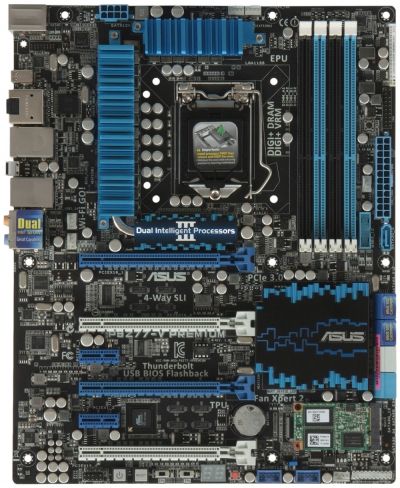
We would like to start describing the board’s features with a multi-phase digital voltage regulator circuitry called “SMART DIGI+”. It is built with high-quality components and provides stable power flow not only to the processor, but also to the graphics core integrated into it and the system memory. The heat-dissipating components are covered with two additional heatsinks and the backplate at the bottom of the PCB also serves as additional heat dissipating surface. All heatsinks are fastened securely with screws and one of them is connected to the central heatsink via a heatpipe. Unlike Asus P8Z77-V Deluxe, the central heatsink on the Premium board is not just for decorative purposes. Just like the similar heatsinks on ASRock Z77 Extreme9 or Gigabyte G1.Sniper 3, it covers the PLX PEX 8747 hub, which provides additional PCI Express lanes to be used for multi-card graphics configurations. As a result, this mainboard distributes the available PCI-E lanes among the slots in a similar way as Intel X79 Express based mainboards do. Not only one, but two graphics cards can actually work at the full PCI Express 3.0/2.0 x16 speed, and you can use as many as four graphics card simultaneously at x8 speed. Asus P8Z77-V Premium allows building Nvidia 4-Way SLI or AMD 4-Way CrossFireX configurations. Moreover, there are two more PCI Express 2.0 x1 slots for expansion cards.
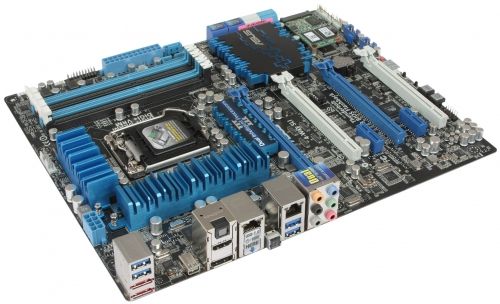
We are already used to the fact that contemporary mainstream and high-end mainboards come equipped with a lot of SATA ports, but this is yet another aspect where Asus P8Z77-V Premium is different from the majority of other products. Intel Z77 Express chipset provides the board with two SATA 6 Gbps ports (white connectors) and four SATA 3 Gbps ports, but we only see three of them: two light-blue ports in the general group and one more a little to the side, close to the memory DIMM slots. The fourth port is laid out as a mini-SATA 3 Gbps with a 32 GB LiteOn LMT-32L3M drive already installed into it. This drive may come in very handy for Intel Smart Response and Rapid Start technologies. Besides that, the mainboard has another four SATA 6 Gbps dark-blue ports, which quite unexpectedly come not from a pair of controller but from one single chip. It is for the first time that we see the new four-port Marvell 88SE9230 controller integrated onto a mainboard. But this is not all: there are two more eSATA 6 Gbps ports on the mainboard back panel, thus making the total number of SATA drives that can be connected to this board equal to twelve.

Overall, there are the following ports and connectors:
- Two eSATA 6 Gbps ports implemented via ASMedia ASM1061 controller;
- Four USB 3.0 ports (blue connectors), two of which are implemented via ASMedia ASM1042 controller. Another two ports and one more internal pin-connector for two additional USB 3.0 ports are provided by Intel Z77 Express chipset;
- Wi-Fi/Bluetooth 4.0 module (AzureWave AW-NB111H);
- Thunderbolt port based on Intel DSL3310 controller;
- An optical S/PDIF and six analogue audio-jacks provided by eight-channel Realtek ALC898 codec;
- HDMI and DisplayPort video outs;
- Two USB 2.0 ports, another four ports are laid out as two onboard pin-connectors;
- “USB BIOS Flashback” button;
- Two local network ports (network adapters are built on Gigabit Intel 82579V and Intel 82583 controllers).
I have to say that AzureWave AW-NB111H “Wi-Fi GO!” module uses Broadcom chipset, supports IEEE 802.11 a/b/g/n in 2.4 GHz and 5 GHz frequency range and Bluetooth 4.0. “USB BIOS Flashback” button will help you to easily update the mainboard BIOS by using the namesake technology. The Deluxe mainboard has all of these features, too, but Asus P8Z77-V Premium also boasts Thunderbolt interface support on top of that.

Like other Asus mainboards, Asus P8Z77-V Premium has convenient wide Q-Slot latches on the graphics card slots and single-sided Q-DIMM latches on the DIMM slots. Besides the glowing Power On and Reset buttons and the “USB BIOS Flashback” button on the mainboard back panel, we see a “MemOK!” button, which lets the board start up successfully even if there are problems with the system memory, and a “Clear CMOS” button for resetting the BIOS settings. The “Q-Led” diodes will quickly indicate where the boot-up failed, and you can always use the POST-code indicator for more detailed diagnostics. The TPU (TurboV Processing Unit) switch will allow you to overclock the CPU automatically, and the EPU (Energy processing Unit) switch will enable more energy-efficient operation mode. The mainboard has two processor fan connectors and four system case fan connectors. All of them are four-pin connectors. The mainboard allows adjusting the processor core voltage in the interval from 0.8 V to 1.92 V, and the memory voltage in the interval from 1.2 V to 1.92 V with a very small increment of 0.005 V. If this is not enough, you can always use the “OV_CPU/DRAM” jumper, which will push the maximum voltage to 2.3 for both parameters. To ensure that all numerous controllers and connectors can coexist in harmony and work at the same time without problems, the board is also equipped with PLX PEX 8606 hub that provides the system with another eight PCI Express 2.0 lanes.
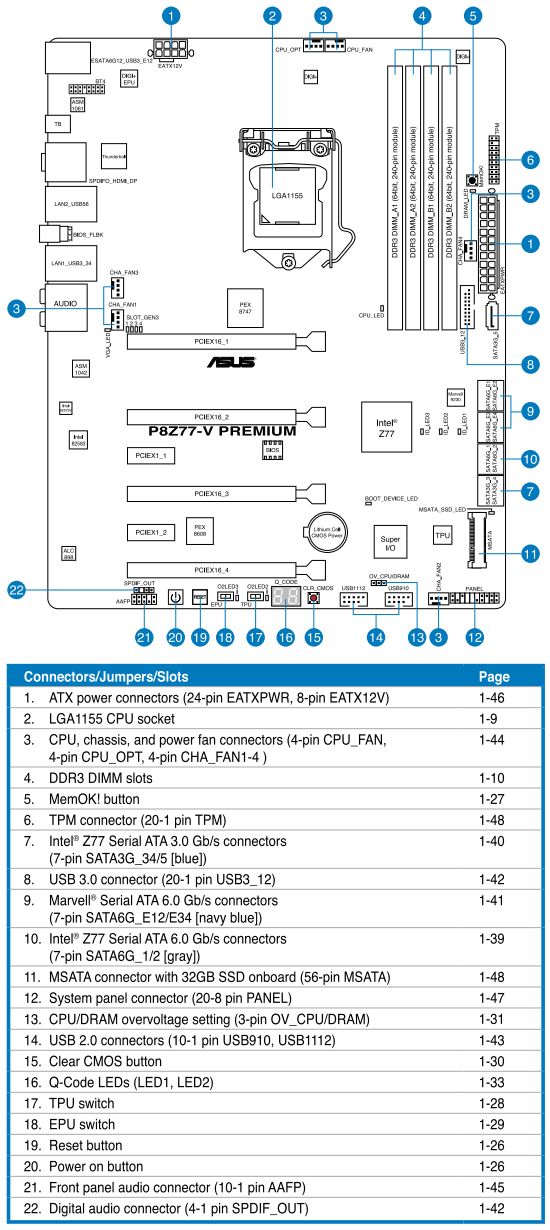
We summed up all the mainboard’s technical specifications in the following table for your convenience:
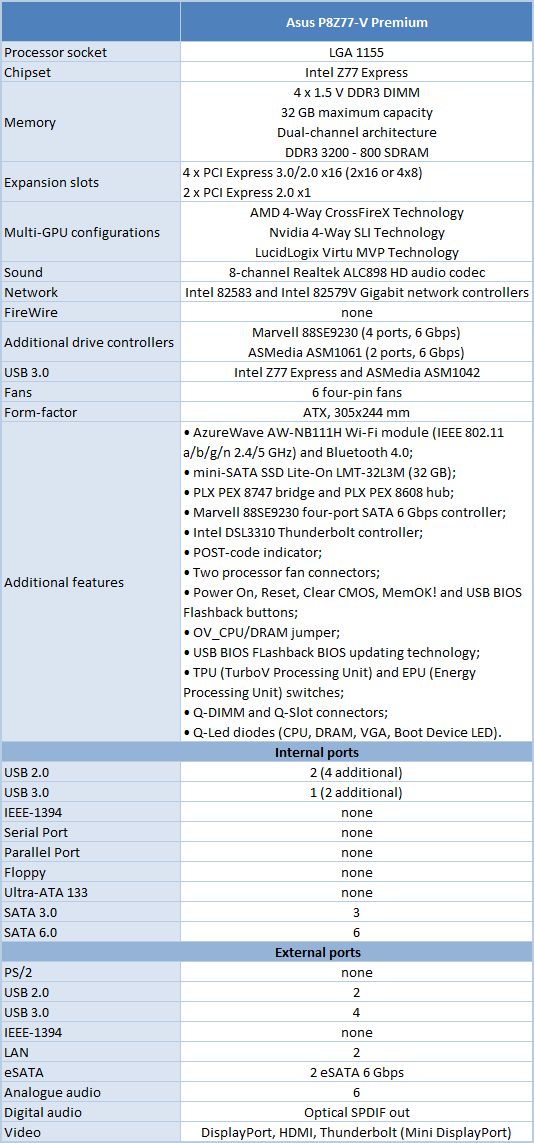
In the very beginning of this review we pointed out that Asus P8Z77-V Deluxe was a very feature-rich product, but Asus P8Z77-V Premium mainboard has more graphics card slots and therefore it supports a wider range of graphics configurations. It also has the additional PLX PEX 8747 hub, which allows these slots to work faster. It also has more SATA ports and comes with a pre-installed mini-SATA SSD Lite-On LMT-32L3M 32 GB drive. Moreover, Asus P8Z77-V Premium supports Thunderbolt technology. The backpanel connector can take a sequence of up to six different devices and a monitor. The mainboard’s accessories bundle is also somewhat richer than that of the Deluxe model. Of course, this board is called “Premium” for a reason: it is truly a high-end product targeted for those users who need to have as much functionality as possible right away.
BIOS Functionality
In our previous reviews of Asus products we have already talked about Asus EFI BIOS – an overall very successful implementation of the UEFI standard (Unified Extensible Firmware Interface). Therefore today we are going to briefly refresh your memory of the major BIOS sections and their parameters and settings.
By default, there is “EZ Mode” enabled in the BIOS. It performs mostly informational functions, because there are barely any configurable parameters there. You can check the basic system settings, some monitoring data, select an energy-efficient or performance mode and set the order of boot-up devices by simply dragging and dropping them with the mouse pointer.
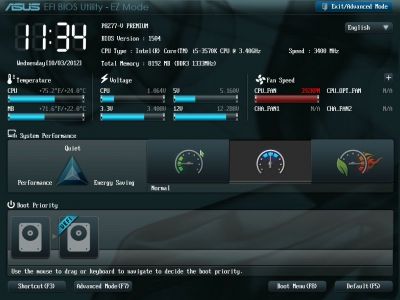
You can quickly switch from “EZ Mode” to “Advanced Mode” by pressing F7, or use the F3 hot key to jump over to one of the most frequently used BIOS sections.
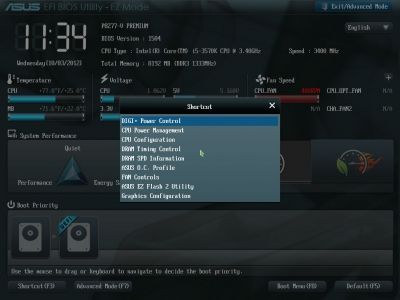
You can switch from “EZ Mode” to “Advanced Mode” every time you enter the BIOS, or press F3 key which also works if pressed while in any other BIOS section, yet it could be much more convenient if you made “Advanced Mode” a default setting. In this case the first section you see will be the familiar “Main” section, where you can receive some basic system information, change the interface language and set up date and time.
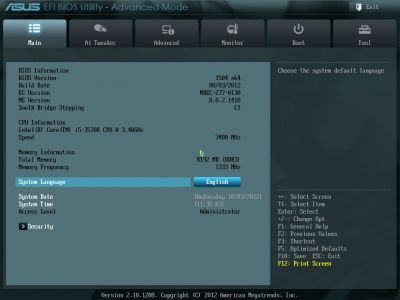
Most of the overclocking-related options are traditionally gathered in the “Ai Tweaker” section. The main section window allows you to change the frequencies, multipliers and voltages. You don’t need to go over to the “Monitoring” section to check the current voltages, as they are all listed right here next to each of the parameters used for changing these voltages, which is highly convenient. The voltages may be set above or below their nominal values.
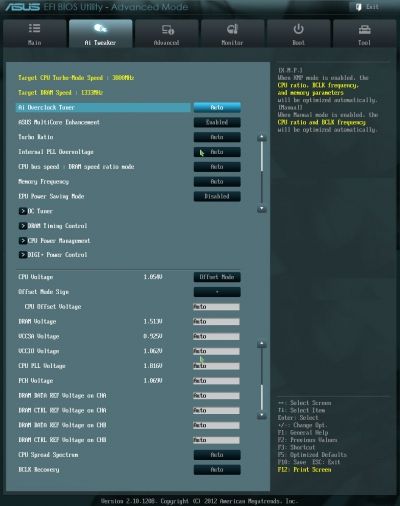
As usual, some parameters are singled out into individual sub-sections in order to unload the main section a little bit. “OC Tuner” parameter only looks like a sub-section, but in reality it helps to automatically overclock the system. The memory timings can be configured on an individual page. They are indeed very numerous, but still very easy to work with. You can see all timings that the mainboard sets for each of the two memory channels. And you can adjust only a few selected timings, such as the main ones, for example, leaving all other settings at defaults.
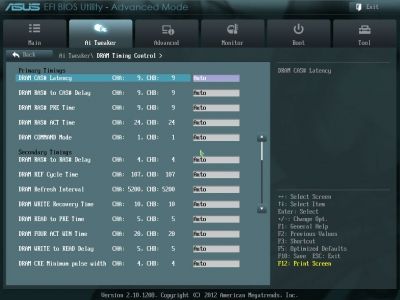
The “CPU Power Management” sub-section allows configuring the parameters affecting “Intel Turbo Boost” technology. However, you do not have to do that, because the board will automatically adjust everything to match your selected overclocking goals.
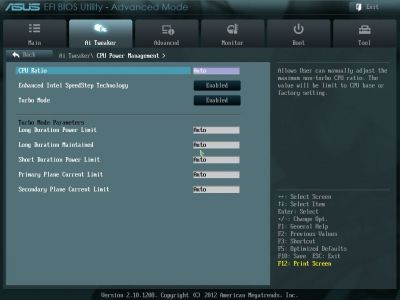
You can’t help noticing numerous options related to the power and energy-efficiency of the digital DIGI+ voltage regulator. You can configure Asus’ proprietary power-saving technologies that allow changing the number of active phases in the voltage regulator circuitry depending on the CPU utilization right in the BIOS. “CPU Load-Line Calibration” technology that prevents the CPU Vcore from dropping under heavy load may be not only enabled or disabled, but also adjusted to deliver the desired effect.
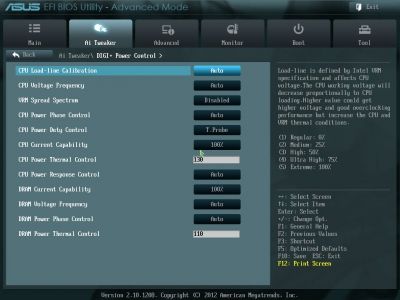
The functionality of the parameters in the sub-sections of the “Advanced” section is quite clear from their names. There is only one new parameter designated to Thunderbolt port.
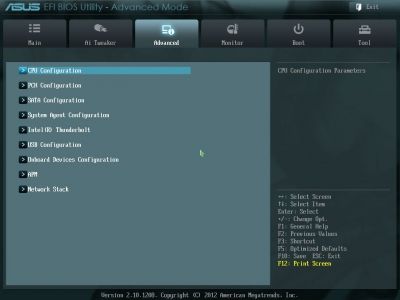
The “CPU Configuration” sub-section reports the basic info about the processor and allows managing some processor technologies.
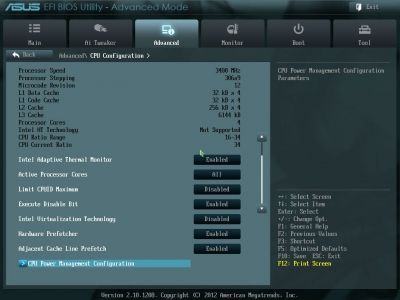
All parameters related to power-saving are singled out on a separate page called “CPU Power Management Configuration”.
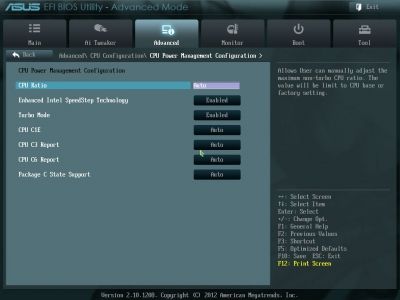
“Monitor” section tells us the current temperatures, voltages and fan rotation speeds. You can select one of the preset modes for the processor and two case fans from a pretty standard list including “Standard”, “Silent” and “Turbo” modes. You can also select the parameters manually. Unfortunately, both processor fans can only be adjustable if they have four-pin connectors.
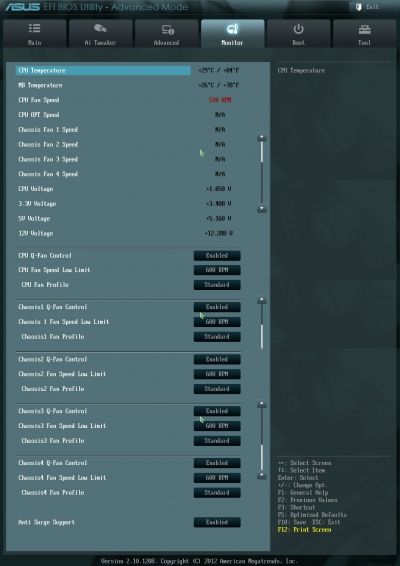
The “Boot” section allows you to adjust your boot-up parameters that will be applied on system start-up. By the way, this is where you have to replace the default “EZ Mode” with “Advanced Mode”.
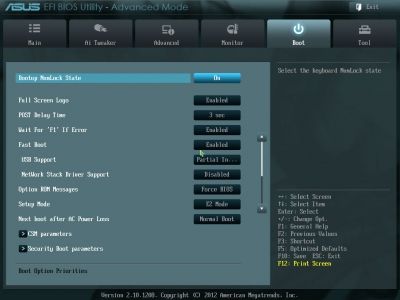
Now let’s quickly refresh the functionality of the “Tools” section.
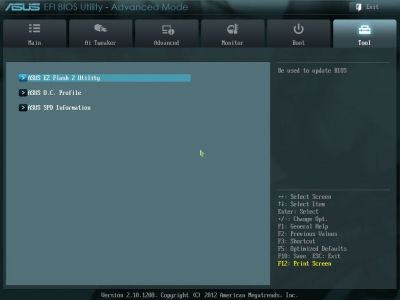
The built-in “EZ Flash 2” utility for BIOS reflashing is one of the most convenient and functional programs of the kind. Unfortunately, they have recently eliminated the option that allowed saving the current BIOS version before reflashing a new one.
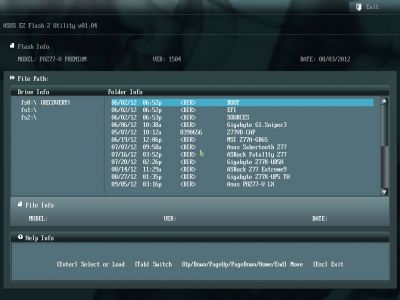
Asus mainboards allow saving and then quickly loading eight full BIOS settings profiles. Each profile may be given a brief descriptive name reminding you of its contents. They still haven’t fixed the issue that doesn’t allow you to save disabling of the startup image in the settings profile, but they brought back the ability to exchange BIOS settings profiles with other users, which was lost upon transition to the EFI BIOS. From now on the profiles may be saved onto external media and loaded from them.
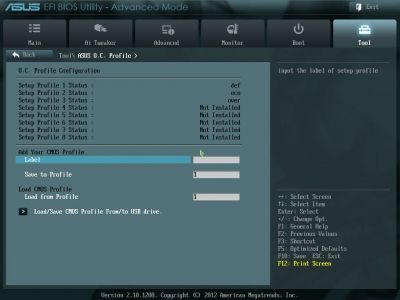
Just like on mainboards from many other makers we can read the information in the memory modules SPD, including the XMP (Extreme Memory Profiles).
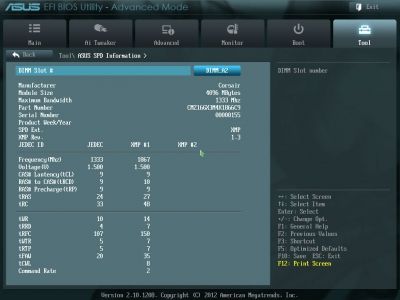
The last section is called “Exit”. Here you can apply the changes, restore the defaults or go back to the “EZ Mode”.
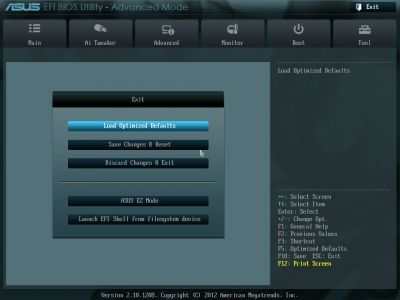
Testbed Configuration
We carried out our tests on a testbed that included the following components:
- Asus P8Z77-V Premium rev.1.02 mainboard (LGA 1155, Intel Z77 Express, BIOS version 1504);
- Intel Core i5-3570K CPU (3.6-3.8 GHz, 4 cores, Ivy Bridge rev.E1, 22nm, 77 W, 1.05 V, LGA 1155);
- 2 x 4 GB DDR3 SDRAM Corsair Vengeance CMZ16GX3M4X1866C9R (1866 MHz, 9-10-9-27 timings, 1.5 V voltage);
- Gigabyte GV-R797OC-3GD graphics card (AMD Radeon HD 7970, Tahiti, 28 nm, 1000/5500 MHz, 384-bit GDDR5 3072 MB);
- Crucial m4 SSD (CT256M4SSD2, 256 GB, SATA 6 Gbps);
- Scythe Mugen 3 Revision B (SCMG-3100) CPU cooler;
- ARCTIC MX-2 thermal interface;
- Enermax NAXN ENM850EWT PSU;
- Open testbed built using Antec Skeleton system case.
We used Microsoft Windows 7 Ultimate SP1 64 bit (Microsoft Windows, Version 6.1, Build 7601: Service Pack 1) operating system, Intel Chipset Software Installation Utility version 9.3.0.1020, AMD Catalyst 12.4 graphics card driver.
Operational and Overclocking Specifics
Since Asus P8Z77-V Premium is not the first Asus mainboard on Intel Z77 Express chipset in our lab, we could probably predict with high degree of probability what we would see. Earlier we pointed out that the board has a very convenient layout and therefore we didn’t have any problems with the system assembly. The first start-up was a success, and it continued to work flawlessly and reboot without any problems later on. There is a start-up image you see on every boot-up, which may differ on different mainboards. The only useful information displayed with the start-up image is the reminder of the “Del” key, which will let you into the BIOS. No other hot keys are mentioned there. In our opinion, it is a drawback, because other mainboard makers display a reminder of the active hot keys for greater user convenience. It would make sense to mention that F8 will display the startup menu, and the “Tab” key will turn off the start-up image and reveal the basic system information. I am sure there are other hot keys, but we do not know what they are, because this information remains hidden from us for some reason. We have already given up hope that this will ever be fixed in the current lineup of Asus mainboards, although we would like to believe that the new boards generation will be free from this issue.

If you press the “Tab” key during start-up, you will disable the start-up image and see the basic system info displayed at this time. Many mainboard makers would duplicate the active hot key reminder list here, too, but Asus is not one of them. We noticed yet another strange thing in the startup screen: the mainboard always displays the nominal CPU clock frequency, and not it actual frequency at the time. For some reason, only ROG (Republic of Gamers) mainboards can display the current CPU frequency correctly, while regular and TUF (The Ultimate Force) mainboards do not know how to do that. Unfortunately, this situation has been going on for a while now, and nothing is being done to change it.
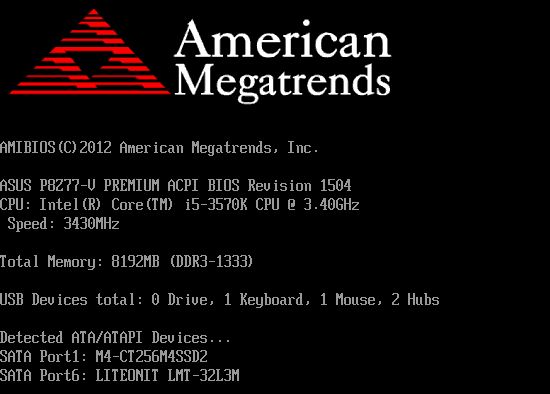
However, we can’t say that we knew everything about Asus P8Z77-V Premium right from the start. In fact, it does have some peculiarities, which we haven’t yet seen before. First of all, it is the pre-installed SSD drive. We were very skeptical about this innovative solution, although previously in our Gigabyte GA-Z68XP-UD3-iSSD review we were very pleased with a drive like that and gave it a highly positive review. There are several reasons for this. Gigabyte mainboard is an entry level mainboard. It is quite possible that upon transition to a new platform the user may want to keep his old hard drive, but speed the system up with the help of a pre-installed small SSD. That is why it could come in very handy in a situation like that. Asus P8Z77-V Premium mainboard is a very expensive flagship product. It is really hard to believe that the owner of a mainboard like that will not invest in a fully-functional high-capacity SSD, especially with all the choices available today. In this case, he or she will have absolutely no use for the small SSD, won’t be able to use Intel Smart Response technology, so the only way this small SSD could be utilized would be for the less popular Intel Rapid Start technology.
However, the most important reason why we gave the pre-installed SSDs on these two mainboards such different assessments is the fact that Gigabyte offers us a choice, and Asus doesn’t. What if all our assumptions are wrong and the owner of an entry-level mainboard also purchases a fast and relatively large SSD instead of the old HDD? In this case he won’t need the pre-installed small SSD that comes with the board that is why we can go and buy the exact same board but without the SSD – Gigabyte GA-Z68XP-UD3. Unlike Gigabyte, Asus doesn’t offer us any options. You can either get a mainboard with this SSD, which may be absolutely useless in many cases, or you can give up Asus P8Z77-V Premium altogether and look for an alternative among the competitors. This is the reason why in our opinion, the pre-installed small SSD is not an advantage in this particular case. Many users won’t even need it, but there is no way to get a mainboard without it. And the 32 GB Lite-On LMT-32L3M drive is actually a pretty common drive. AS SSD utility shows that its read speed is quite decent, but its write speed is suspiciously low.
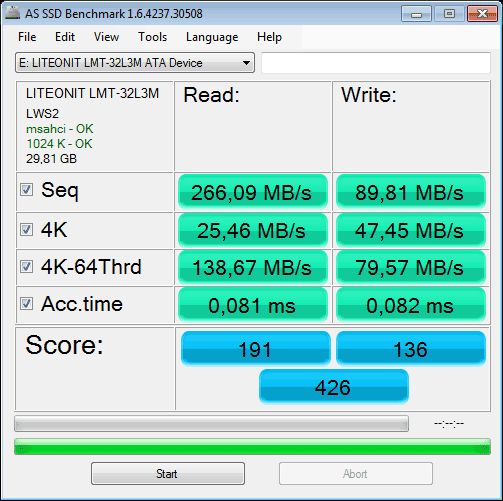
In our Asus P9X79 Deluxe mainboard review we discussed the company’s proprietary “Asus SSD Caching” program and were very pleased with its performance. On some occasions marketing promises may be noticeably different from the actual results, but they promised us to triple the performance, and this was exactly what we got. The results were particularly valuable, because Intel Smart Response technology didn’t work on Intel X79 Express based mainboards, so it was the only way to speed up the hard drive performance. In case of Asus P8Z77-V Premium mainboard, we see a new four-port Marvell 88SE9230 controller for the first time, which functionality can be unveiled with the help of “Asus SSD Caching II” utility, which uses Marvell HyperDuo Plus technology. Thanks to the four SATA 6 Gbps ports we now have more drive combination options. For example, you can accelerate one HDD using three different SSDs, or combine two HDDs with two SSDs.
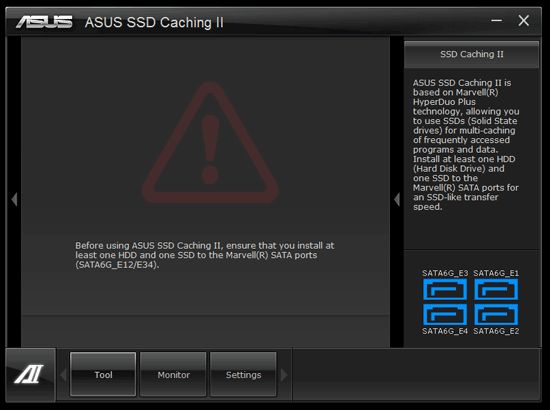
Almost all Asus mainboards on Intel Z77 Express chipset use similar algorithms for automatic processor overclocking. If you use the “OC Tuner” parameter in the mainboard BIOS, the base clock will increase to 103 MHz, which will affect all connected frequencies, including the memory frequency. In this case, the processor clock frequency multiplier will increase to 41x. These two factors alone will boost the processor speed to 4224 MHz. it is important to mention that all processor power-saving technologies will remain up and running and will continue to lower the processor clock frequency multiplier and core voltage in idle mode.
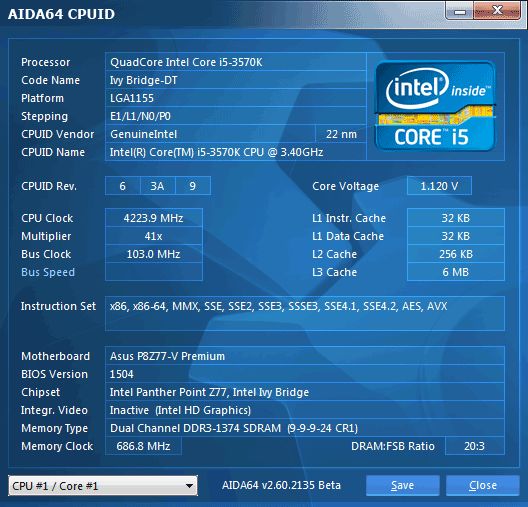
We got the same result on Asus P8Z77-V Deluxe, Asus P8Z77-V LX and Asus Sabertooth Z77. However, Asus Maximus V Formula turned out more of a disappointment in this respect. It uses different algorithms for automatic overclocking, which are completely unfit for Ivy Bridge processors. As a result, both overclocking options involving “Gamer’s OC Profile” and “CPU Level Up” parameters turned out non-operational, because they would cause throttling, which lowered the performance instead of boosting it. However, everyone knows that no automatic overclocking can be as effective as manual search for the most optimal parameters. Unfortunately, Asus P8Z77-V Premium mainboard didn’t let us overclock our test processor to its maximum frequency of 4.6 GHz, but it easily reached 4.5 GHz. We also increased the memory frequency and adjusted the timings accordingly.
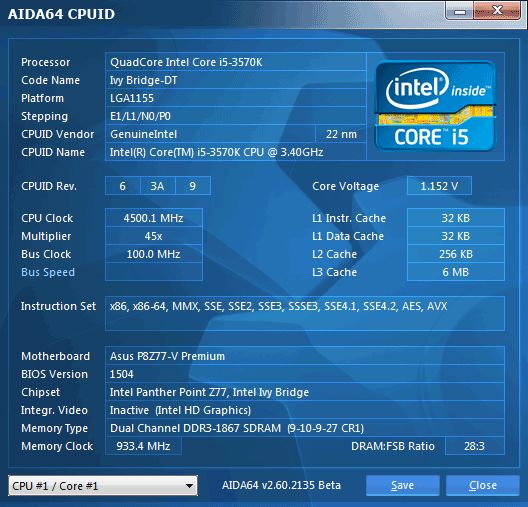
Now I would only like to remind you that we always overclock mainboards in such a way that they could be used for a prolonged period of time in this mode. We do not try to make our life easier by disabling any of the mainboard features, such as onboard controllers, for example. We also try to keep the CPU’s power-saving technologies up and running normally to the best of our ability. And this time all power-saving technologies remained up and running even during overclocking lowering the CPU voltage and frequency multiplier in idle mode.
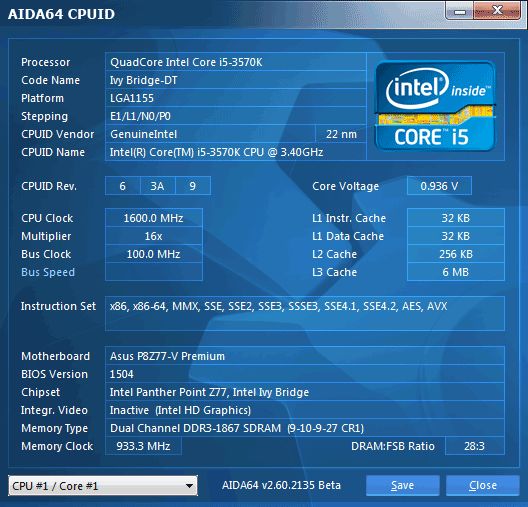
Performance Comparison
As usual, we are going to compare the mainboards speeds in two different modes: in nominal mode and during CPU and memory overclocking. The first mode is interesting because it shows how well the mainboards work with their default settings. It is a known fact that most users do not fine-tune their systems, they simply choose the optimal BIOS settings and do nothing else. That is why we run a round of tests almost without interfering in any way with the default mainboard settings. For comparison purposes we also included the results of the previously reviewed mainboards:
- ASRock Fatal1ty Z77 Professional
- ASRock Z77 Extreme4 and ASRock Z77 Extreme6
- ASRock Z77 Extreme9
- ASRock Z77 OC Formula
- Asus Maximus V Formula
- Asus P8Z77-V Deluxe
- Asus P8Z77-V LX
- Asus Sabertooth Z77
- Gigabyte G1.Sniper 3
- Gigabyte GA-Z77X-UD3H and GA-Z77X-UD5H-WB WIFI
- Gigabyte GA-Z77X-UP4 TH and Gigabyte GA-Z77X-UP5 TH
- Intel DZ77BH-55K
- Intel DZ77GA-70K and Intel DZ77RE-75K
- MSI Z77A-GD65.
The results on the diagrams are sorted out in descending order. The results of Asus P8Z77-V Premium mainboard are highlighted with a darker color for your convenience.
Nominal Mode
We used Cinebench 11.5. All tests were run five times and the average result of the five runs was taken for the performance charts.
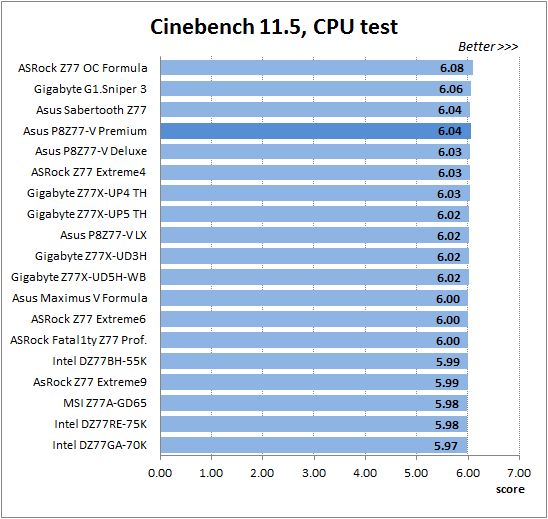
We have been using Fritz Chess Benchmark utility for a long time already and it proved very illustrative. It generated repeated results, the performance in it is scales perfectly depending on the number of involved computational threads.
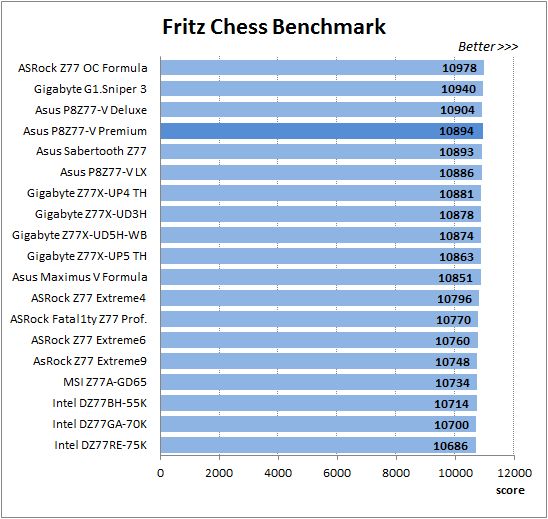
A small video in x264 HD Benchmark 4.0 is encoded in two passes and then the entire process is repeated four times. The average results of the second pass are displayed on the following diagram:
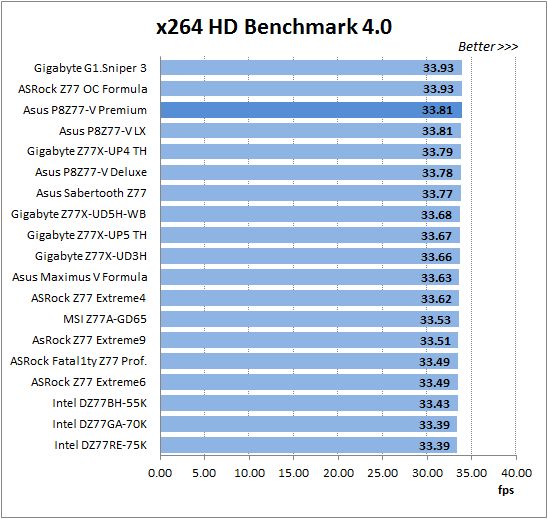
We measured the performance in Adobe Photoshop using our own benchmark made from Retouch Artists Photoshop Speed Test that has been creatively modified. It includes typical editing of four 10-megapixel images from a digital photo camera.
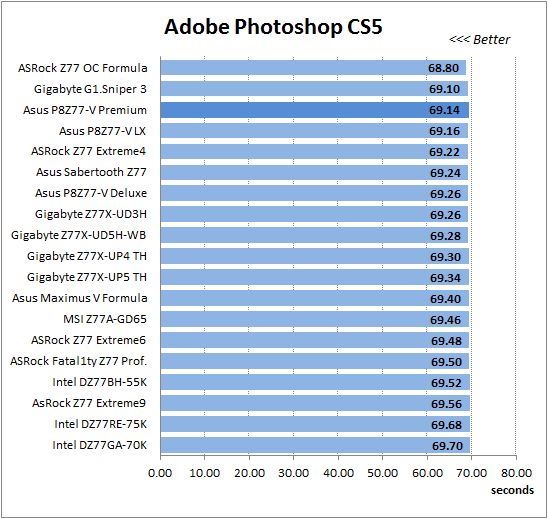
In the archiving test a 1 GB file is compressed using LZMA2 algorithms, while other compression settings remain at defaults.
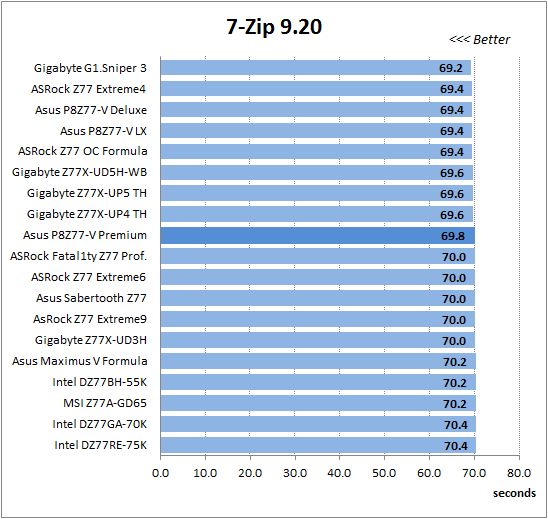
Like in the data compression test, the faster 16 million of Pi digits are calculated, the better. This is the only benchmark where the number of processor cores doesn’t really matter, because it creates single-threaded load.
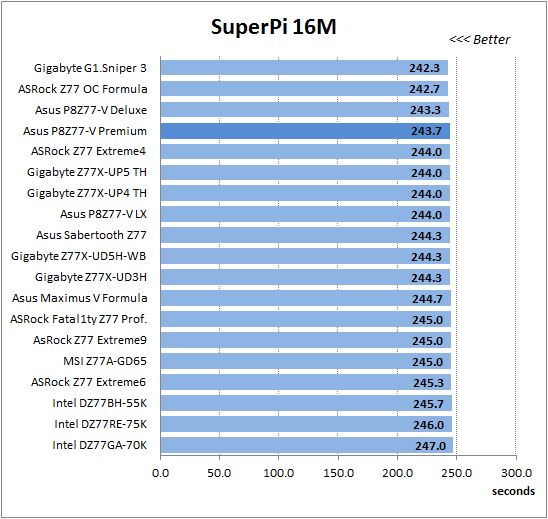
Since we do not overclock graphics in our mainboard reviews, the next diagram shows only CPU tests from the 3DMark11 – Physics Score. This score is obtained in a special physics test that emulates the behavior of a complex gaming system working with numerous objects:
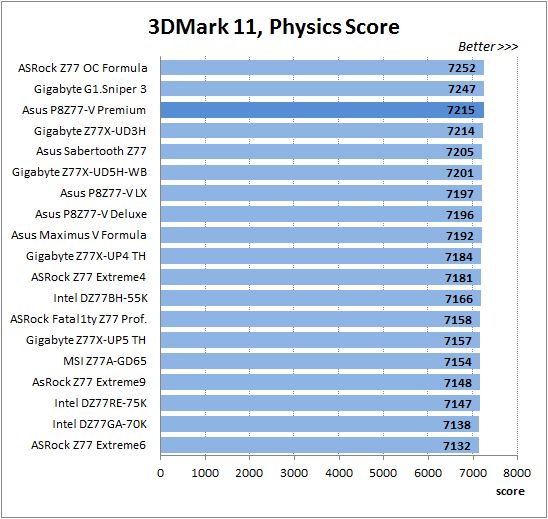
We use FC2 Benchmark Tool to go over Ranch Small map ten times in 1920×1080 resolution with high image quality settings in DirectX 10.
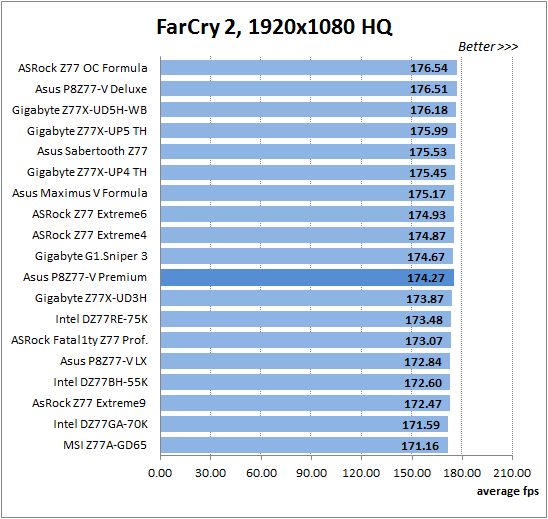
Resident Evil 5 game also has a built-in performance test. Its peculiarity is that it can really take advantage of multi-core processor architecture. The tests were run in DirectX 10 in 1920×1080 resolution with high image quality settings. The average of five test runs was taken for further analysis:
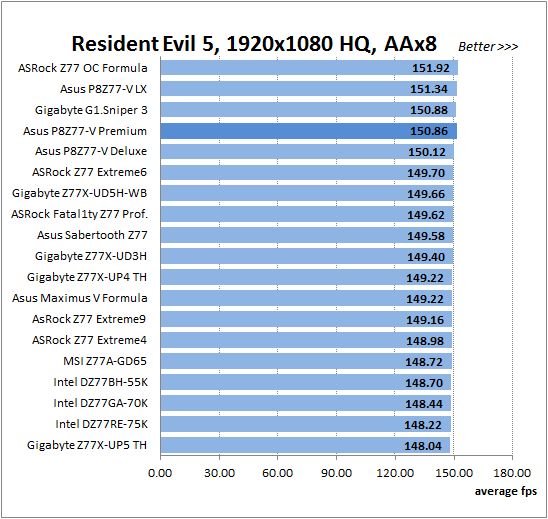
Batman: Arkham City game also reacts eagerly to any changes in the CPU clock frequency, but it uses DirectX 11. We ran game’s integrated benchmark five times with high image quality settings and then take the average of the five runs for the diagrams.
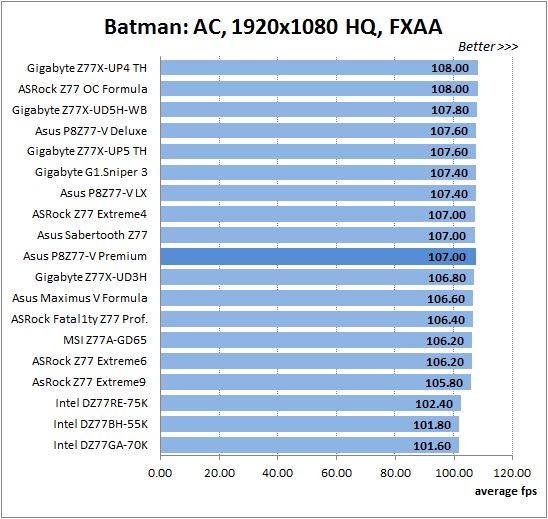
We didn’t uncover anything unexpected. Asus P8Z77-V Premium mainboard performs pretty much as fast as other mainboards working in the same testing conditions.
Overclocked Mode
During processor and memory overclocking, different mainboards accomplished different results, which we summed up in the following table for your convenience:
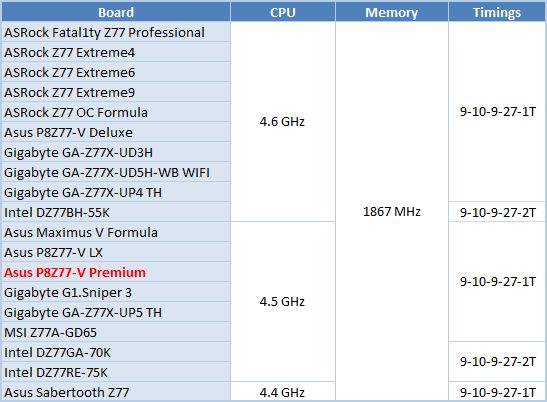
Asus P8Z77-V Premium performance during overclocking is also fine. It maintains average speed, it practically doesn’t stand out among other mainboards with similar processor and memory overclocking. The only exception is the games, where it was, frankly, somewhat slow. This could be caused by additional latencies from the PLX PEX 8747 hub, because two other mainboards featuring the same controller also didn’t do too well in games and demonstrated comparable results with those of Asus P8Z77-V Premium.
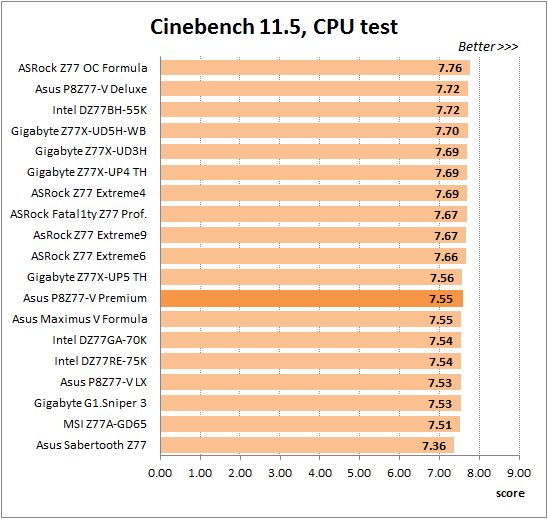
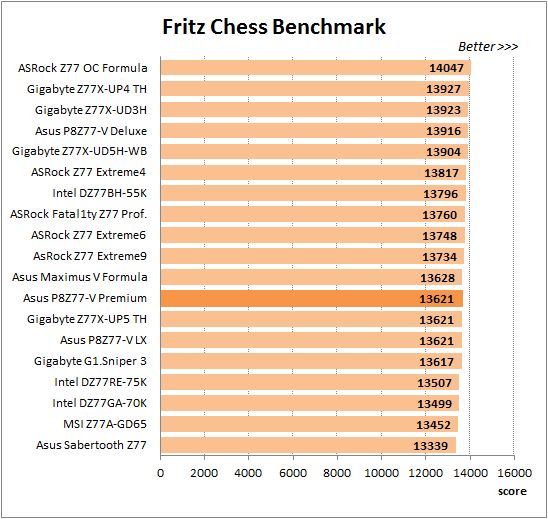
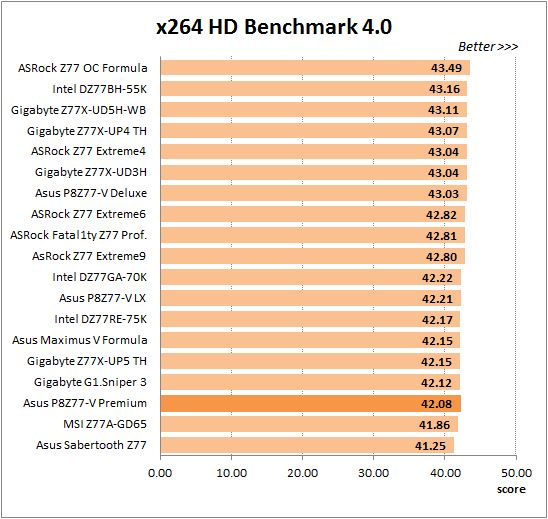
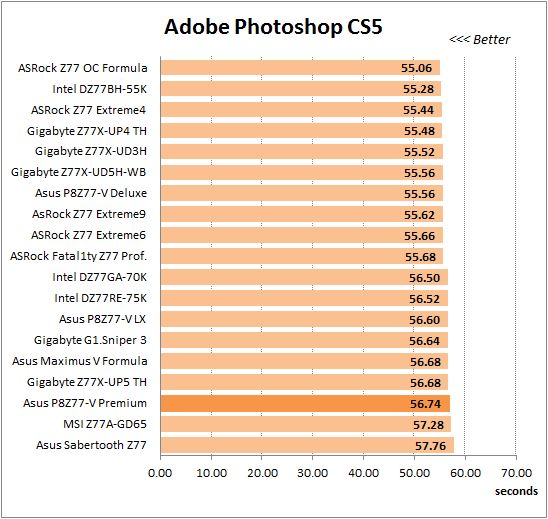
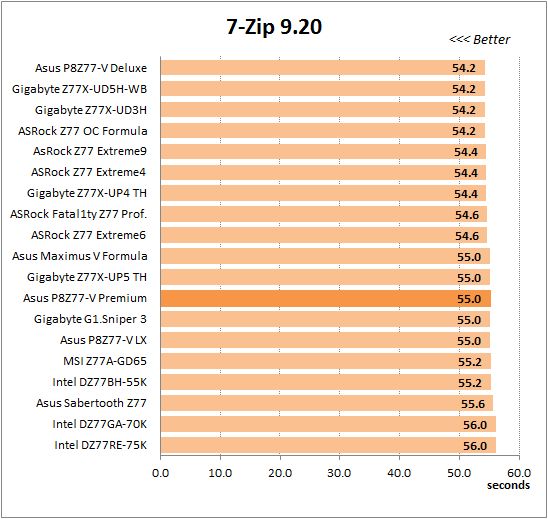
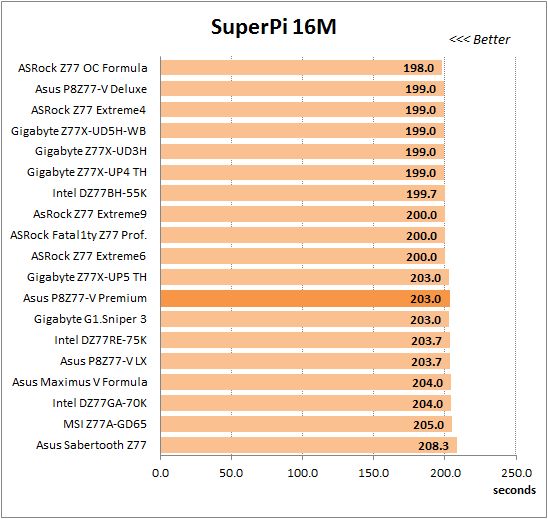
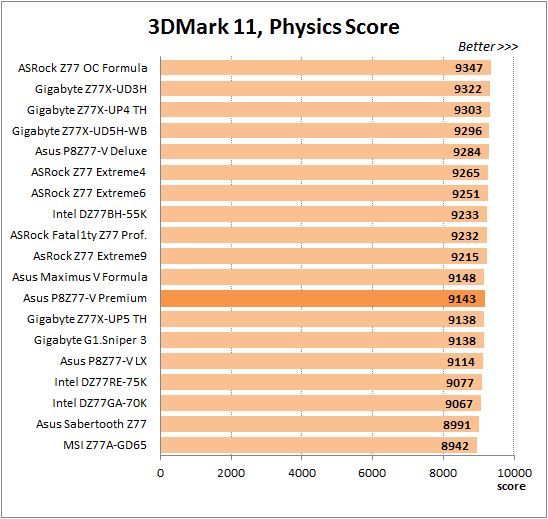
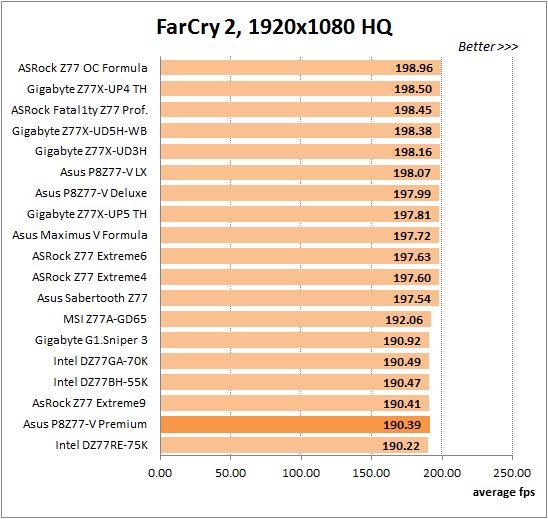
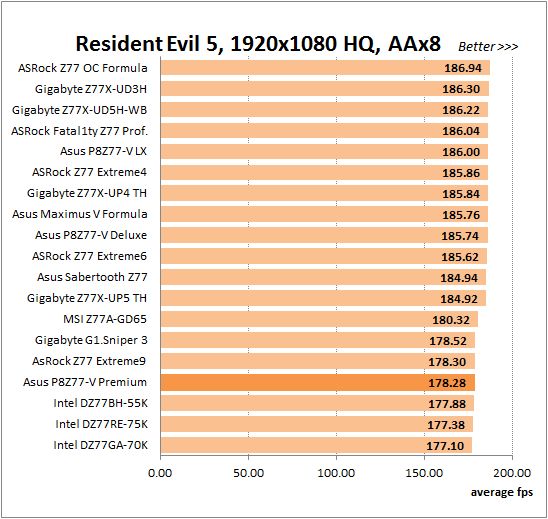
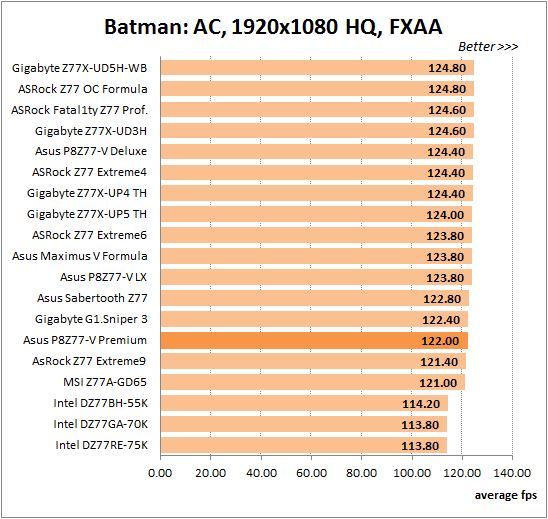
Power Consumption
We performed our power consumption measurements using an Extech Power Analyzer 380803. This device is connected before the PSU and measures the power draw of the entire system (without the monitor), including the power loss that occurs in the PSU itself. In the idle mode we start the system up and wait until it stops accessing the hard disk. Then we use LinX to load the CPU. For a more illustrative picture there are graphs that show how the computer power consumption grows up depending on the number of active execution threads in LinX (both at the default and overclocked system settings). The results of Asus P8Z77-V Premium are marked with darker color for your convenience.
Because of compatibility issues we uncovered in Gigabyte GA-Z77X-UP4 TH and Gigabyte GA-Z77X-UP5 TH mainboards with our original CoolerMaster RealPower M850 power supply unit, we had to replace it with Enermax NAXN ENM850EW. Both these PSUs have very similar technical characteristics, but Enermax NAXN ENM850EWT is about 1-3 W more energy-efficient than the Cooler Master unit. In order to be able to use the previously obtained results, we decided to make up for this efficiency difference by adding 2 W to all new power readings, so that we could still compare their results against the power consumption of all previously tested products.
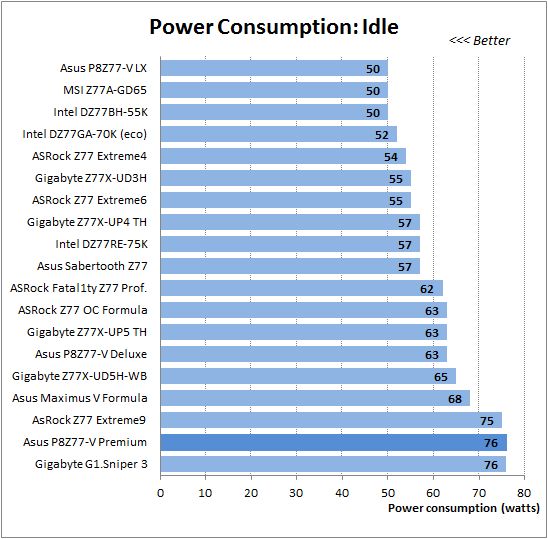
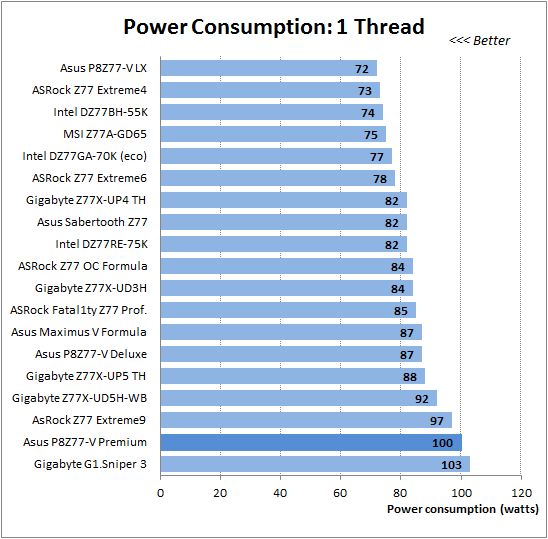
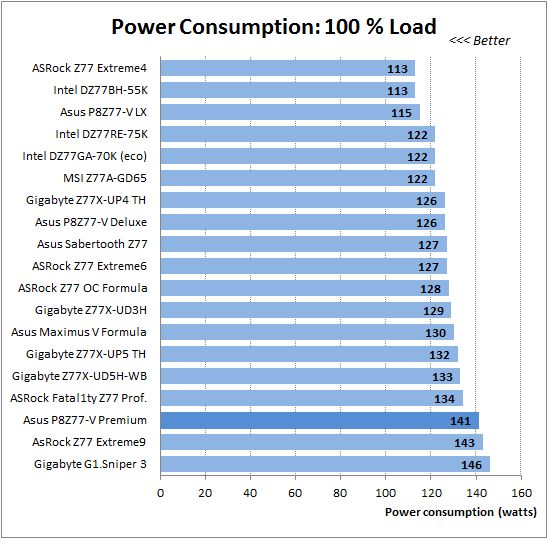
We knew beforehand that the additional PLX PEX 8747 hub makes Asus P8Z77-V Premium mainboard consume more than an average board. We tested three mainboards with this controller and all of them demonstrated significantly different levels of power consumption than the other testing participants. However, you can slightly improve the board’s energy-efficiency if you manually enable all power-saving technologies in the BIOS.
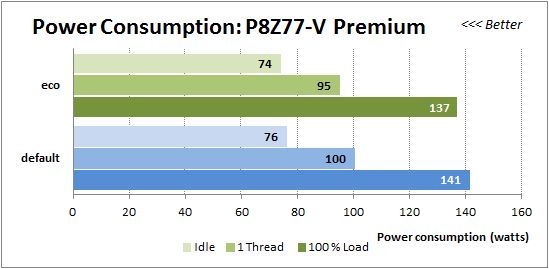
During system overclocking when there is insignificant load or none at all, Asus P8Z77-V Premium consumes more power than average, which is typical for mainboards with the PLX PEX 8747 controller. However, under maximum operational load the board suddenly became pretty energy-efficient, compared against Gigabyte G1.Sniper 3 mainboard, which overclocked the processor to the same 4.5 GHz. Yes, ASRock Z77 Extreme9 consumes much more power in this case, but it also overclocked the test CPU better.
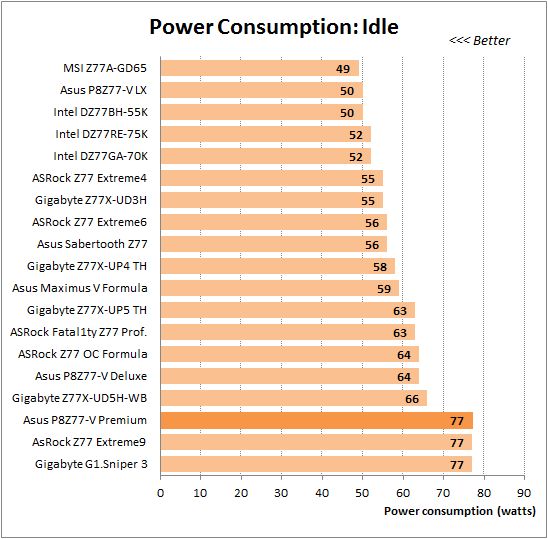
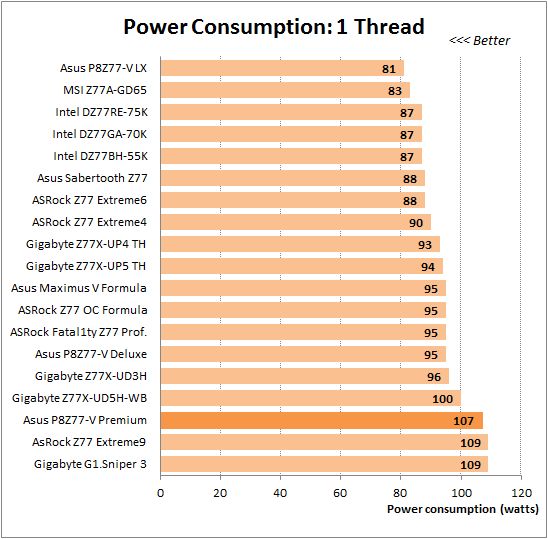
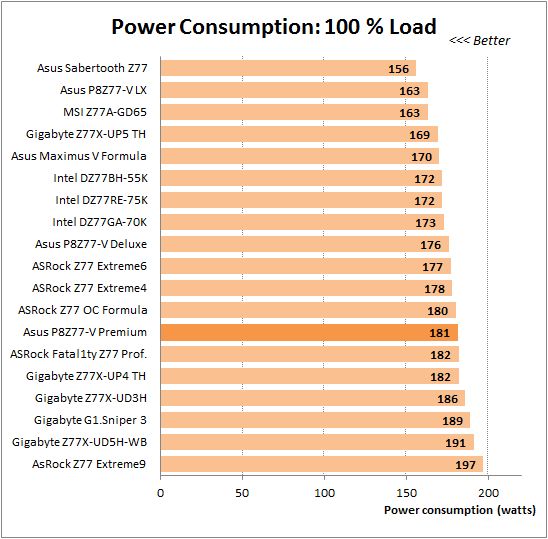
Conclusion
Overall Asus P8Z77-V Premium makes a very good impression, although there are a few things which we would ideally like to get fixed. And among them are not only the ones related to this specific model, but the things that we see across all Asus products. For example, the absence of hot key list on the start-up screen or the incorrect information displayed when start-up image is disabled. High price is also a drawback to some extent, but at the same time it serves as a guarantee that this mainboard won’t be a random purchase, but it will rather end up in the system of a user who really needs it and has thought things trough. Let’s try to determine who could be a potential ideal target for a product like Asus P8Z77-V Premium.
It is highly desired that whoever decided to go with an Asus P8Z77-V Premium should have a mechanical hard disk drive, which could be accelerated substantially with a miniature SSD pre-installed onto this board and Intel Smart Response technology. Otherwise, this feature will be simply wasted. It would be even better to have a few HDDs – potential candidates for acceleration, because in this case you could take advantage of the extensive functionality of the four-port SATA 6 Gbps Marvell 88SE9230 controller and Asus SSD Caching II utility. In fact, it would be best if you had multiple SATA drives, because this mainboard allows connecting ten internal drives (one of them with mSATA interface) and two more external eSATA drives. The board has two local network connectors, and both adapters are based on Gigabit Intel network controller, which is some cases may allow combining their functionality. The Wi-FI GO! module supporting dual-band Wi-Fi and Bluetooth 4.0 is also a nice touch. The board is equipped with a PLX PEX 8747 hub providing additional PCI Express lanes, which may and even must be used for graphics card configurations, otherwise, this hub will be simply wasting your precious power. By the way, in terms of energy-efficiency, all mainboards with this hub consume significantly more power, which is usually perceived as a drawback. However, you could view it from a different perspective. The additional hub allows Asus P8Z77-V Premium to distribute the PCI-E lanes similarly to the way an Intel X79 Express based mainboard would. At the same time, it is a fact that an Asus P8Z77-V Premium based system will be always more energy-efficient, faster and in some cases even less expensive than an LGA 2011 system with a similar functionality.
It is pretty hard to find a user, who will be able to utilize all or almost all the features Asus P8Z77-V Premium has to offer, because some of them do not really exclude the other functions, but duplicate them or make them less valuable. For example, if you have high-speed wireless connection, then you don’t really need two integrated network adapters. You will most likely use only one of them, but not both of them simultaneously. The same is true for caching. The pre-installed SSD implies that it will be used with Intel Smart Response technology, but in this case there is really no need for the four-port Marvell 88SE9230 controller and the other way around. I would also like to add that you most definitely should have at least a two- card graphics configuration, or maybe even more than that. As a result, the situation becomes somewhat paradoxical: the extensive functionality of Asus P8Z77-V Premium doesn’t expand but rather narrows the potential user pool for this product. Besides, each additional feature affects the price of the board, which ends up being pretty high.
That said, Asus P8Z77-V Premium could be of great interest due to its drive connectivity, graphics configurations support, networking and wireless technologies. It comes with an mSATA SSD and supports Thunderbolt technology. This is a high-end model for those users who need very extensive functionality and they want it immediately.